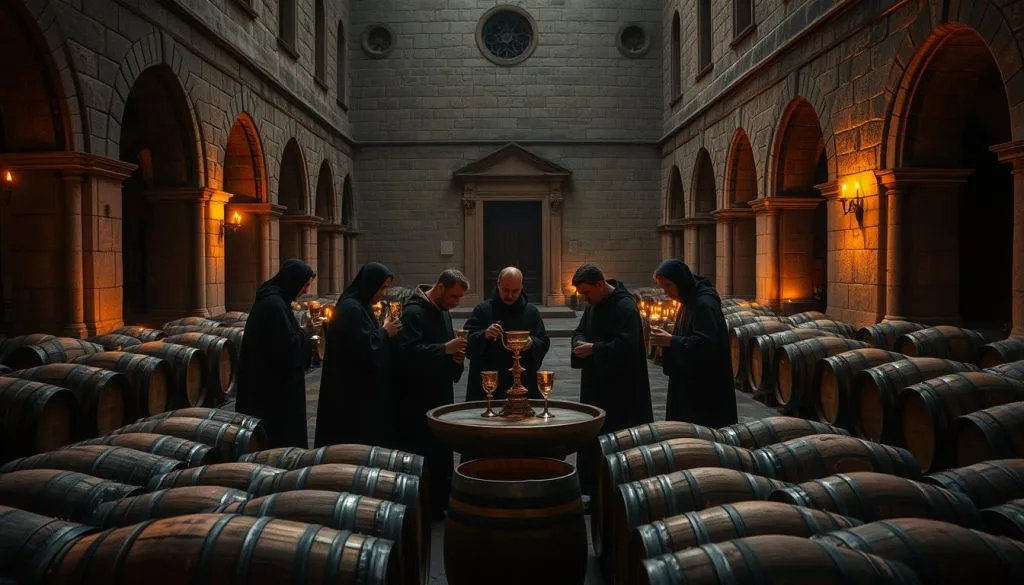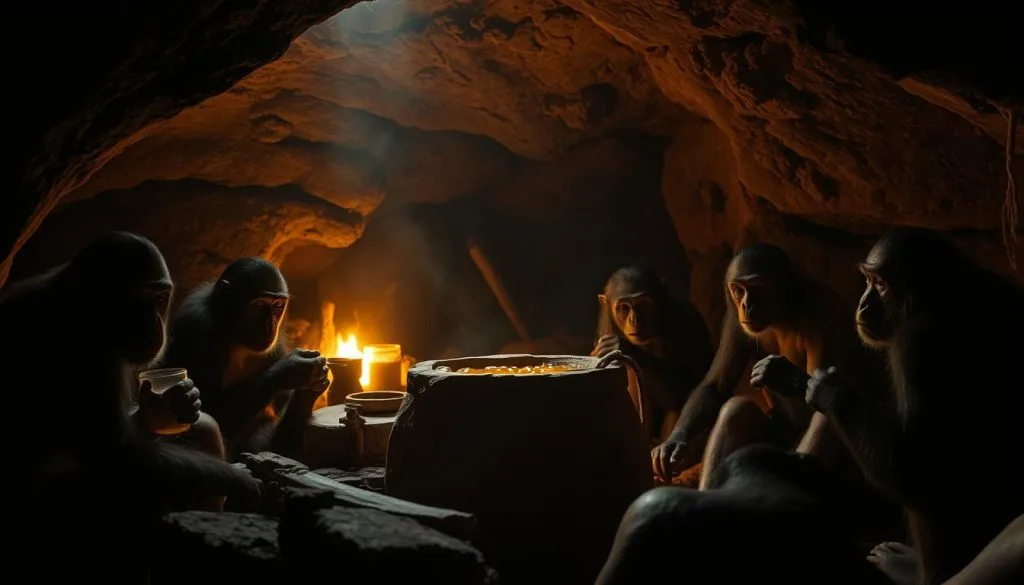This post may contains affiliate links. Read our full disclosure here.
Imagine a world where grape juice accidentally fermented 7,000 years ago—sparking humanity’s oldest happy accident. This boozy alchemy didn’t just create alcohol; it birthed a cultural revolution. From ancient rituals to rooftop rosé nights, wine’s story drips with intrigue.
Archaeologists struck gold in Armenia’s Areni-1 cave: the world’s oldest winery. Clay pots stained with grape residue prove our ancestors weren’t just surviving—they were crafting vibes. Similar finds in Georgia and Sicily reveal vineyards weren’t mere farms but sacred spaces where myth met science.

Dionysus partied hard in Greek tales, while Bacchus became Rome’s ultimate influencer. These gods didn’t just symbolize indulgence—they coded wine into religion, trade, and power moves. Fast-forward to today: that bottle of Cabernet? It’s carrying millennia of drama in every sip.
But here’s the twist: early winemaking wasn’t some Insta-perfect hobby. It was messy trial-and-error, blending chemistry with spirituality. The juice of crushed grapes became currency, sacrament, and art—proving that good ideas age better than oak barrels.
From Babylonian taverns to Napa Valley’s chic tasting rooms, wine’s origin story remains a blend of grit and glam. Ready to uncork how fermented grapes shaped empires, inspired revolutions, and became the ultimate flex? Let’s pour into the past.
Origins: Prehistory and Vine Domestication
Picture this: nomadic tribes stumbling upon boozy grape mush—humanity’s first liquid luck. Wild vitis vinifera grapes grew like weeds across Eurasia, their sugary fruit begging to ferment. Crush them in animal skins? Instant happy hour circa 6000 BCE.
From Foraging to Farming
Archaeologists hit paydirt in Georgia’s Zagros Mountains. Those iconic Kvevri jars—egg-shaped clay vessels buried underground—still hold grape residue from 8,000 years ago. At Iran’s Hajji Firuz Tepe, a 9-liter pottery jar contained tartaric acid traces: receipts from history’s first wine subscription box.
Vine Whisperers Emerge
Early vintners weren’t just lucky—they were plant scientists. By selecting hermaphroditic vines that self-pollinated, they hacked nature’s code. Permanent settlements replaced nomadic life, letting farmers perfect the fermentation process using airtight ceramic tech. Pro tip: add terebinth resin to prevent spoilage (and impress Neolithic foodies).
This wasn’t just about getting lit. Grape pips found in Egyptian tombs show deliberate cultivation—the OG vineyard vibes. From Armenian cave wineries to resin-flavored vintages, our ancestors turned survival into an art form. Cheers to that.
The History of Wine
Long before TikTok trends, fermented grapes became humanity’s original viral sensation. From Georgia’s 6000 BCE wine relics to Rome’s empire-building vino highways, each sip carries coded stories of power, survival, and rebellion.
Phoenician traders were the OG influencers, shipping amphoras across the Mediterranean like ancient Amazon Prime. Their routes birthed France’s vineyards and Italy’s dolce vita ethos. Meanwhile, monks in Burgundy turned cellars into flavor labs, perfecting techniques while Europe crumbled.
The 16th century flipped the script: Spanish missionaries hauled vines to the Americas, sparking New World rivalries. Then came the 1800s’ phylloxera apocalypse—nature’s reset button—forcing vintners to graft European vines onto hardy American roots. Crisis birthed innovation, as always.
Today’s natural wine movement? Just a callback to Neolithic methods minus the goat-skin jugs. That $50 Cabernet in your glass? It’s sipping on 8,000 years of trial, error, and terroir-driven swagger. From sacred rituals to Silicon Valley boardrooms, vino remains the ultimate status symbol with a PhD in survival.
Ancient Civilizations and Winemaking Practices
Ancient empires didn’t just conquer lands—they fermented revolutions in clay. From Nile-side ceremonies to Athenian symposiums, wine became cultural currency, blending ritual with raw innovation. This wasn’t mere drinkcraft; it was empire-building through terroir.
Egyptian, Greek, and Levantine Traditions
Pharaohs toasted eternity with herb-infused vintages—Cleopatra’s Muscat of Alexandria still flows today. Tomb frescoes reveal wine as afterlife VIP passes, while amphorae stamped with regal seals hint at early appellation systems. Across the Mediterranean, Phoenician traders became the OG influencers, shipping resin-sealed amphorae like Bronze Age sommeliers.
Greeks elevated viticulture to high art. Their symposia mixed watered wines with philosophy, served in kraters painted with Dionysian escapades. Aristotle warned about hangovers centuries before brunch culture, proving some truths never age.
Roman Innovations in Viticulture
Rome didn’t just drink—they engineered. Screw presses crushed grapes faster than TikTok trends, while Pliny the Elder cataloged 91 wine varieties in his 1st-century CE hit list. Legionnaires guzzled 3 liters daily, turning Gaulish vineyards into empire fuel stations.
Their viticulture playbook? Law-coded quality controls and terracotta dolia for aging. Modern Italian Falerno del Massico still nods to ancient Falernian—proof that good wine outlives even marble empires.
Cultural and Religious Significance of Wine
Sacred goblets overflowed long before #blessed became a thing. Across temples and tabernacles, fermented grapes morphed into divine elixir—bridging mortals to gods through ritual sips. This wasn’t just happy hour; it was holy protocol.

Mythic Traditions and Rituals
Dionysus didn’t just party—he coded wine into Greek DNA as a godly side hustle. Followers guzzled diluted vino during Anthesteria festivals, believing intoxication unlocked spiritual portals. Romans upgraded the vibe: Bacchanalia orgies turned wine into ritual currency, traded for divine favors and political clout.
Scriptural and Ceremonial Roles
Noah’s post-flood vineyard set the biblical bar for self-care gone wild. Fast-forward to Jesus’ first miracle: turning water into wine at a wedding—because even messiahs knew dry weddings suck. The Last Supper sealed wine’s sacred rep, with red varieties symbolizing sacrificial blood across Christian rites.
Monks later turned communion wine into a medieval health hack, prescribing it for everything from plague anxiety to bad breath. Prohibition-era loopholes? Churches kept the holy juice flowing, saving vineyards from extinction. Today’s natural wine movement? Just Dionysus 2.0 with better branding.
Evolution of Winemaking Techniques
Stomp grapes in a clay vat one day, program a robotic harvester the next—winemaking’s glow-up rivals any tech startup’s pivot. Ancient vintners were OG biohackers, using resin-coated amphorae and foot-crushed grapes to outsmart spoilage. Today’s production lines hum with AI-driven precision, turning terroir into vino algorithms.
Bare Feet to Brainy Tech
Roman cellar masters aged wine in oak barrels—a revelation after centuries of leaky clay jars. Medieval monks nailed quality control with single-vineyard batches, while 19th-century chemists like Pasteur decoded fermentation science. That rustic charm? Mostly winemaking survival tactics before stainless steel tanks offered temperature-controlled swagger.
Silicon Valley Meets Napa
Modern production ditches guesswork for laser sorters that weed out subpar grapes. Automated harvesters work 24/7, avoiding the “2 AM vineyard panic” familiar to ancient farmers. Bottling lines now sterilize with space-age tech, replacing risky wax seals. The result? Your $30 Pinot tastes like a sommelier-approved science project.
From hand-squeezed pulp to IoT-connected fermenters, wine’s evolution mirrors humanity’s hustle: preserve tradition while chasing perfection. One truth remains—whether aged in caves or labs, every bottle still needs someone to say, “Damn, that’s good.”
Global Expansion and Trade of Wine
Before hashtags and cargo ships, amphorae-clad ships moved the world’s first luxury good: wine. Phoenician traders became the OG hypebeasts, slinging clay jars of fermented grape juice across Mediterranean trade routes like ancient DoorDashers. Their maritime hustle planted vineyards in Greece, Italy, and France—regions still flexing their terroir cred today.
Liquid Currency Builds Empires
Rome didn’t just conquer lands—they uncorked markets. Legionnaires marched with vines as strategic gear, turning Gaul (modern France) into a wine powerhouse. Amphorae labels detailed vineyard origins and vintages—a 1st-century BCE version of TikTok unboxing videos.
Colonialism later turbocharged globalization. Spanish missionaries hauled cuttings to Mexico, while British settlers planted vines in Australia’s Barossa Valley. These forced relocations birthed New World wines, blending European tradition with rebellious terroir twists.
| Era | Key Players | Innovations | Legacy Regions |
|---|---|---|---|
| 1200-500 BCE | Phoenicians | Resin-sealed amphorae | Sicily, Sardinia |
| 27 BCE-476 CE | Romans | Oak barrel aging | Bordeaux, Rioja |
| 16th-19th c. | Colonial Powers | Grapevine grafting | Napa, Mendoza |
Today’s $200 Cabernet owes its swagger to these ancient hustle cultures. Modern trade routes see Chilean Carménère hitting Tokyo bars while Georgian qvevri wines trend in Brooklyn. Globalization didn’t dilute wine’s soul—it turned regional quirks into global flexes.
Wine in Art, Literature, and Society
Paintbrushes dipped in Cabernet, typewriters stained with Merlot—artists have long used wine as both medium and muse. From Sumerian banquet scenes etched 4,500 years ago to Sofia Coppola’s Instagrammable Marie Antoinette spreads, fermented grapes remain culture’s ultimate flex.
Historical Depictions and Symbolism
Ancient Greeks turned drinking into high art. Euphronios’ krater vases immortalized tipsy philosophers debating at symposia—the original dinner party aesthetic. Roman mosaics flaunted Bacchus lounging with overflowing chalices, a not-so-subtle flex of wealth. Even Egyptian tomb murals showed servants pressing grapes, proving good wine was a VIP ticket to the afterlife.
Fast-forward to Hemingway’s A Moveable Feast, where Parisian cafés flowed with vin ordinaire that fueled literary revolutions. Today, that $300 bottle on Succession isn’t just prop decor—it’s a culture code for power plays. From Georgian gold goblets to influencer #WineWednesday posts, the use of vino as social shorthand never aged out.
Modern ads use Dionysian imagery with a Silicon Valley twist. Ever notice how that Sauvignon Blanc commercial mirrors a Bacchanalia fresco? Same decadence, better lighting. Whether splashed across Pompeian walls or TikTok thirst traps, wine remains liquid storytelling—one part tradition, two parts rebellion.
Anthropological Perspectives: From Drunken Monkeys to Stone Age Wines
Millions of years before Instacart deliveries, primates stumbled upon nature’s happy hour. Rotting fruit dripping with ethanol became an accidental buffet—and our ancestors’ taste for fermented grapes might be written into our DNA. This isn’t just ancient bar trivia; it’s evolutionary biology with a buzz.

Biological Roots and the Drunken Monkey Hypothesis
UC Berkeley scientist Robert Dudley argues our love for wine started 10 million years ago. Primates like Malaysia’s pen-tailed tree shrew still binge on naturally fermented bertam palm nectar—a living snapshot of pre-human liquid cravings. Ethanol-rich fruit offered calories and antimicrobial perks, making tipsy foraging a survival hack.
Scientific Theories of Early Fermentation
Patrick McGovern’s “Paleolithic hypothesis” rewrites winemaking history. Residue analysis of 9,000-year-old Chinese pottery jars reveals a wild cocktail: grapes, rice, and honey brewed into proto-wine. Early humans didn’t invent fermentation—they hijacked it from nature’s playbook.
| Theory | Key Figure | Evidence | Timeline |
|---|---|---|---|
| Drunken Monkey | Robert Dudley | Primate ethanol consumption | 10M years BP |
| Paleolithic Brewing | Patrick McGovern | Jiahu pottery residues | 7000 BCE |
| Stone Age Fermentation | Archaeological teams | Iranian wine jars | 5400 BCE |
From jungle-floor mush to intentional winery practices, this biological handshake between grape and primate shaped civilization’s favorite drink. Next time you swirl a glass, remember: you’re sipping on 10 million years of microbial matchmaking.
Impact of Technological Innovations and Pasteurization
Forget artisanal charm—today’s winemakers wield tech like Instagram filters. Louis Pasteur’s 19th-century yeast studies cracked fermentation’s code, turning wine from rustic gamble to precision craft. His heat-treatment method (63°C for 30 minutes) nuked bacteria without killing flavor—a health hack that saved vineyards from spoilage chaos.
Modern bottles and stainless steel tanks replaced leaky amphoras and mold-prone barrels. Temperature-controlled fermentation lets vintners tweak flavors like DJs mixing tracks. Computerized sensors track pH levels, ensuring every batch stays Instagram-perfect.
Advances in Quality Control and Storage
Harvesting grapes once meant calloused hands and prayers. Now, optical sorters scan 10 tons hourly, ejecting subpar fruit with robot precision. HTST pasteurization (72°C for 15 seconds) turbocharges production while locking in quality—think fast fashion, but for wines that age gracefully.
Sealing innovations? Corks got competition. Screw caps and synthetic stoppers cut oxidation risks, letting Chilean Carménère survive transatlantic flights. These upgrades transformed bottles into global passports—your local bodega now stocks Georgian qvevri vintages beside Napa Cabernets.
The effects ripple beyond taste. Pasteur’s legacy birthed ISO-certified labs where sommeliers in lab coats profile tannins like forensic scientists. From vine to shelf, tech ensures your $50 Pinot isn’t just drinkable—it’s liquid quality control with Insta-worthy precision.
Wine as a Reflection of Regional Terroirs

A vineyard’s GPS coordinates might as well be its flavor DNA—terroir writes the script that grapes perform. This French concept (no direct translation) captures how soil, climate, and topography conspire to create liquid place. Burgundy’s limestone-heavy dirt births Chardonnay with razor-sharp minerality, while Napa’s volcanic soils inject Cabernet with brooding dark fruit. Geography isn’t just backdrop; it’s the lead actor.
Old World regions wear terroir like tailored suits. Mosel’s steep slate slopes force Riesling vines to dig deep, yielding wines with electric acidity and petrol whispers. Bordeaux’s gravel banks drain excess water, stressing Merlot grapes into producing thicker skins—and bolder tannins. “The land speaks first,” says a Rhône Valley winemaker. “We just translate.”
New World regions riff on tradition with local swagger. Oregon’s Willamette Valley mimics Burgundy’s climate but adds basalt bedrock twists to its Pinot Noir. Argentina’s Mendoza plants Malbec at 3,000 feet, where Andean sun meets glacial meltwater—a high-altitude process crafting velvety wines with backbone.
Human hands curate nature’s chaos. Bordeaux’s vineyard masters blend Cabernet and Merlot like perfumers balancing notes. In Piedmont, Nebbiolo grapes get tannin-taming oak treatment without smothering the region’s rose-and-tar signature. It’s alchemy: part science, part poetry.
Why does terroir matter? That $80 Barolo isn’t just fermented grape juice—it’s a liquid memoir of fog-draped hills and generations’ grit. Every sip whispers coordinates.
New World vs. Old World Wine Traditions
Old World wines whisper through cobblestone alleys; New World bottles blast from rooftop decks. Europe’s regions treat winemaking like sacred texts—Bordeaux’s appellation rules haven’t budged since Napoleon’s time. Meanwhile, Napa vintners rewrite the playbook with laser-guided harvesters and oak alternatives that would make Burgundians clutch their pearls.
Grapevine Grafting and Phylloxera Recovery
The 19th-century phylloxera apocalypse nearly wiped out Europe’s vines. Solution? Graft French vitis vinifera onto American rootstock—a Frankenstein move that saved wine as we know it. Today’s Old World purists still debate whether this biotech hack compromised quality, while New World rebels flaunt their pest-resistant vines like flex culture.
Contrasting Styles and Global Trends
Old World red wines taste like geography exams—Burgundian Pinot Noir whispers “wet limestone,” Barolo growls “tar and roses.” New World bottles? Think TikTok dances: Aussie Shiraz explodes with blueberry jam, Argentine Malbec struts violet notes. The 1976 Judgment of Paris was the ultimate plot twist—California Cabernets outscoring Bordeaux’s century-old icons.
Modern drinkers want both: Rioja makers use concrete eggs for funky textures, while Oregon wineries resurrect qvevri techniques. As climate change reshapes regions, the real winner? Your glass—stocked with 8,000 years of drama and tomorrow’s experiments.
Conclusion
Fermented grape alchemy has outlived empires, survived plagues, and reinvented itself through every epoch. From Persian princesses discovering wine’s magic to Armenian cave wineries setting the blueprint, this liquid time capsule carries humanity’s grit and glamour in every drop.
Roman screw presses and monastic cellars laid groundwork for today’s industry, where drones monitor Napa vines while Georgian qvevri jars keep ancient methods alive. That tension—tradition versus tech—fuels a $364 billion global market thriving on heritage and hustle.
Alcohol once reserved for gods now fuels rooftop brunches and boardroom deals. Yet each bottle remains rooted in 8,000 years of soil science, cultural rebellion, and accidental genius. Modern sommeliers aren’t just pouring drinks—they’re curating living archives.
Next time you swirl a glass, remember: you’re tasting more than grape juice. You’re sipping on humanity’s unbroken thread—where Phoenician traders meet Silicon Valley disruptors, and every sip whispers, “What’s next?”




